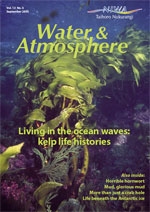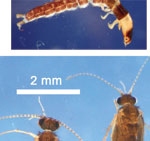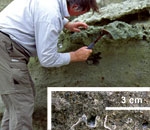PDF of this article (153 KB)

Classifying caddis

Commonly known as a caddisfly, Zelandoptila moselyi is a small insect belonging to the aquatic order Trichoptera. The larva (or juvenile) is thought to live on submerged wood in streams; the adults are dull, moth-like insects that fly at night. All but one of the 240+ species of caddisflies known to New Zealand are endemic, which means that our species are unique and found nowhere else in the world.
Historically, Zelandoptila has had an unstable relationship with taxonomists, undergoing many name changes since it was first described in 1924. The larva of Zelandoptila has previously been misidentified as another species, while the adult is believed to have been placed in the wrong caddisfly family.
Brian Smith recently travelled to USA to work with internationally renowned Trichoptera experts at the Smithsonian Institution in Washington, DC, and at Clemson University in South Carolina; his goal was to set the record straight. His work involved a phylogenetic comparison of Zelandoptila with related caddisflies from throughout the world. Phylogenetics is a field of biology that deals with identifying and understanding the relationships between the many different kinds of life on earth.
Zelandoptila is currently placed in the family Psychomyiidae, but Brian’s phylogenetic analysis indicates that it should be transferred to the family Ecnomidae. Although Psychomyiidae has over 400 species worldwide, in New Zealand its only representative has been Z. moselyi. Reclassifying Zelandoptila will remove the name Psychomyiidae from the New Zealand fauna. This will not change the number of caddisfly species known from New Zealand, but it will reduce the number of families present to 15.
For further information, contact: Brian Smith, 0-7-856 1756, [email protected]
Ancient glass sponges record palaeobiodiversity


Living glass sponges (or hexactinellids) are generally found only in deep waters around New Zealand. Michelle Kelly from NIWA and John Buckeridge from Auckland University of Technology have discovered fossil glass sponges from about 53-60 million years ago (late Palaeocene to early Eocene age). The sponge fossils are exposed in cliffs at the mouth of the Tutuiri Stream, along the beach on the north coast of Chatham Island. These fossils are the most beautifully preserved glass sponges known of any age from the New Zealand region.
What is so special about these fossils is their skeletal structure: delicate spikes, or spicules, of silica are woven into mesh 'nets'. Their exquisite detail can be seen with scanning electron microscopy. These skeletons are all that now remains of the once-living sponges. They provide special insight into the biodiversity of the area they inhabited, for they acted as bio-samplers, accumulating (or trapping) other sponge spicules that were present in the environment at that time. When they died, other sponges' spicules drifted along the bottom, to become enmeshed in the glass sponge skeletons.
These sponge-body and spicule fossils represent a fauna that was once dominated by glass sponges (Class Hexactinellida) and demosponges (Class Demospongiae). The Tutuiri fauna is believed to have lived in inner to mid-shelf water depths (50-250 m deep), but the fauna is more like that of the present-day soft-sediment environment of the Chatham Rise at 800-1200 m depth. This indicates that these sponges, like some other invertebrate groups such as barnacles, have significantly changed habitat over the last 50 million years.
The discovery and identification of the Tutuiri fauna is documented in Kelly, M.; Buckeridge, J.S. (2005). An early Paleogene sponge fauna, Chatham Island, New Zealand. NZ Journal of Marine and Freshwater Research 39: 899-914 available at www.rsnz.org/publish/nzjmfr/2005/071.php
For further information, contact: Dr Michelle Kelly, 0-9-375 2037, [email protected]
